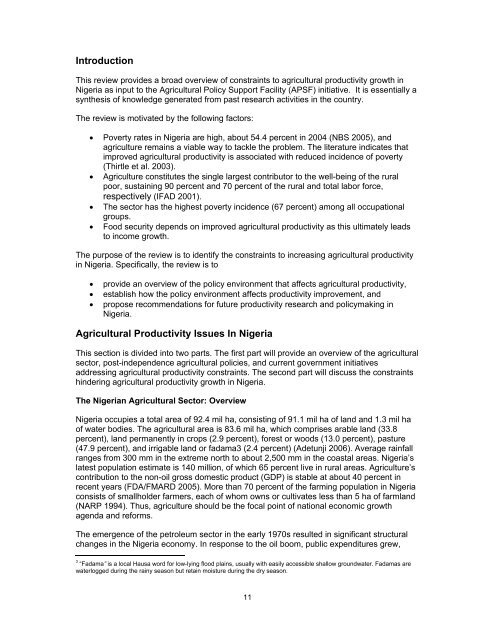Constraints to Increasing Agricultural Productivity in Nigeria: A Review
Constraints to Increasing Agricultural Productivity in Nigeria: A Review
Constraints to Increasing Agricultural Productivity in Nigeria: A Review
Create successful ePaper yourself
Turn your PDF publications into a flip-book with our unique Google optimized e-Paper software.
Introduction<br />
This review provides a broad overview of constra<strong>in</strong>ts <strong>to</strong> agricultural productivity growth <strong>in</strong><br />
<strong>Nigeria</strong> as <strong>in</strong>put <strong>to</strong> the <strong>Agricultural</strong> Policy Support Facility (APSF) <strong>in</strong>itiative. It is essentially a<br />
synthesis of knowledge generated from past research activities <strong>in</strong> the country.<br />
The review is motivated by the follow<strong>in</strong>g fac<strong>to</strong>rs:<br />
Poverty rates <strong>in</strong> <strong>Nigeria</strong> are high, about 54.4 percent <strong>in</strong> 2004 (NBS 2005), and<br />
agriculture rema<strong>in</strong>s a viable way <strong>to</strong> tackle the problem. The literature <strong>in</strong>dicates that<br />
improved agricultural productivity is associated with reduced <strong>in</strong>cidence of poverty<br />
(Thirtle et al. 2003).<br />
Agriculture constitutes the s<strong>in</strong>gle largest contribu<strong>to</strong>r <strong>to</strong> the well-be<strong>in</strong>g of the rural<br />
poor, susta<strong>in</strong><strong>in</strong>g 90 percent and 70 percent of the rural and <strong>to</strong>tal labor force,<br />
respectively (IFAD 2001).<br />
The sec<strong>to</strong>r has the highest poverty <strong>in</strong>cidence (67 percent) among all occupational<br />
groups.<br />
Food security depends on improved agricultural productivity as this ultimately leads<br />
<strong>to</strong> <strong>in</strong>come growth.<br />
The purpose of the review is <strong>to</strong> identify the constra<strong>in</strong>ts <strong>to</strong> <strong>in</strong>creas<strong>in</strong>g agricultural productivity<br />
<strong>in</strong> <strong>Nigeria</strong>. Specifically, the review is <strong>to</strong><br />
provide an overview of the policy environment that affects agricultural productivity,<br />
establish how the policy environment affects productivity improvement, and<br />
propose recommendations for future productivity research and policymak<strong>in</strong>g <strong>in</strong><br />
<strong>Nigeria</strong>.<br />
<strong>Agricultural</strong> <strong>Productivity</strong> Issues In <strong>Nigeria</strong><br />
This section is divided <strong>in</strong><strong>to</strong> two parts. The first part will provide an overview of the agricultural<br />
sec<strong>to</strong>r, post-<strong>in</strong>dependence agricultural policies, and current government <strong>in</strong>itiatives<br />
address<strong>in</strong>g agricultural productivity constra<strong>in</strong>ts. The second part will discuss the constra<strong>in</strong>ts<br />
h<strong>in</strong>der<strong>in</strong>g agricultural productivity growth <strong>in</strong> <strong>Nigeria</strong>.<br />
The <strong>Nigeria</strong>n <strong>Agricultural</strong> Sec<strong>to</strong>r: Overview<br />
<strong>Nigeria</strong> occupies a <strong>to</strong>tal area of 92.4 mil ha, consist<strong>in</strong>g of 91.1 mil ha of land and 1.3 mil ha<br />
of water bodies. The agricultural area is 83.6 mil ha, which comprises arable land (33.8<br />
percent), land permanently <strong>in</strong> crops (2.9 percent), forest or woods (13.0 percent), pasture<br />
(47.9 percent), and irrigable land or fadama3 (2.4 percent) (Adetunji 2006). Average ra<strong>in</strong>fall<br />
ranges from 300 mm <strong>in</strong> the extreme north <strong>to</strong> about 2,500 mm <strong>in</strong> the coastal areas. <strong>Nigeria</strong>’s<br />
latest population estimate is 140 million, of which 65 percent live <strong>in</strong> rural areas. Agriculture’s<br />
contribution <strong>to</strong> the non-oil gross domestic product (GDP) is stable at about 40 percent <strong>in</strong><br />
recent years (FDA/FMARD 2005). More than 70 percent of the farm<strong>in</strong>g population <strong>in</strong> <strong>Nigeria</strong><br />
consists of smallholder farmers, each of whom owns or cultivates less than 5 ha of farmland<br />
(NARP 1994). Thus, agriculture should be the focal po<strong>in</strong>t of national economic growth<br />
agenda and reforms.<br />
The emergence of the petroleum sec<strong>to</strong>r <strong>in</strong> the early 1970s resulted <strong>in</strong> significant structural<br />
changes <strong>in</strong> the <strong>Nigeria</strong> economy. In response <strong>to</strong> the oil boom, public expenditures grew,<br />
3 “Fadama” is a local Hausa word for low-ly<strong>in</strong>g flood pla<strong>in</strong>s, usually with easily accessible shallow groundwater. Fadamas are<br />
waterlogged dur<strong>in</strong>g the ra<strong>in</strong>y season but reta<strong>in</strong> moisture dur<strong>in</strong>g the dry season.<br />
11
















